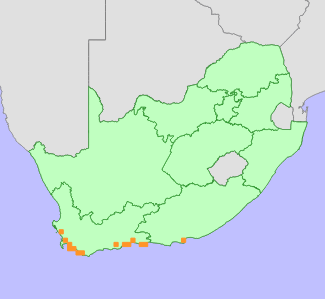Disa hallackii is widespread, but confined to a limited habitat on coastal lowlands. It was thought to be extremely rare, and at one stage was known from a single subpopulation near Mossel Bay (Linder 1999), but recently, a number of previously unrecorded subpopulations have been discovered. There are currently between eight and 11 remaining subpopulations. Survey data for nine of these indicate that subpopulations are very small, the largest consisting of around 150 mature individuals. Two subpopulations are protected in private nature reserves, and two other in a provincial nature reserve and a national park, but the rest are all threatened by ongoing habitat loss and degradation.
|
Goldblatt, P. and Manning, J.C. 2000. Cape Plants: A conspectus of the Cape Flora of South Africa. Strelitzia 9. National Botanical Institute, Cape Town.
Hall, A.V., De Winter, M., De Winter, B. and Van Oosterhout, S.A.M. 1980. Threatened plants of southern Africa. South African National Scienctific Programmes Report 45. CSIR, Pretoria.
Hilton-Taylor, C. 1996. Red data list of southern African plants. Strelitzia 4. South African National Botanical Institute, Pretoria.
Liltved, W.R. and Johnson, S.D. Unpublished. The Cape Orchids - Wild orchids of the Cape Floral Kingdom.
Linder, H.P. 1981. Taxonomic studies in the Disinae. III. A revision of Disa Berg. excluding sect. Micranthae Lindl. Contributions from the Bolus Herbarium 9:1-370.
Linder, H.P. 1999. Disa. In: H.P. Linder and H. Kurzweil (eds.), Orchids of southern Africa (pp. 187-288), A.A. Balkema, Rotterdam.
Raimondo, D., von Staden, L., Foden, W., Victor, J.E., Helme, N.A., Turner, R.C., Kamundi, D.A. and Manyama, P.A. 2009. Red List of South African Plants. Strelitzia 25. South African National Biodiversity Institute, Pretoria.
Victor, J.E. 2002. South Africa. In: J.S. Golding (ed), Southern African plant Red Data Lists. Southern African Botanical Diversity Network Report 14 (pp. 93-120), SABONET, Pretoria.
Victor, J.E. and Dold, A.P. 2003. Threatened plants of the Albany Centre of Floristic Endemism, South Africa. South African Journal of Science 99:437-446.
|
 Comment on this assessment
Comment on this assessment


